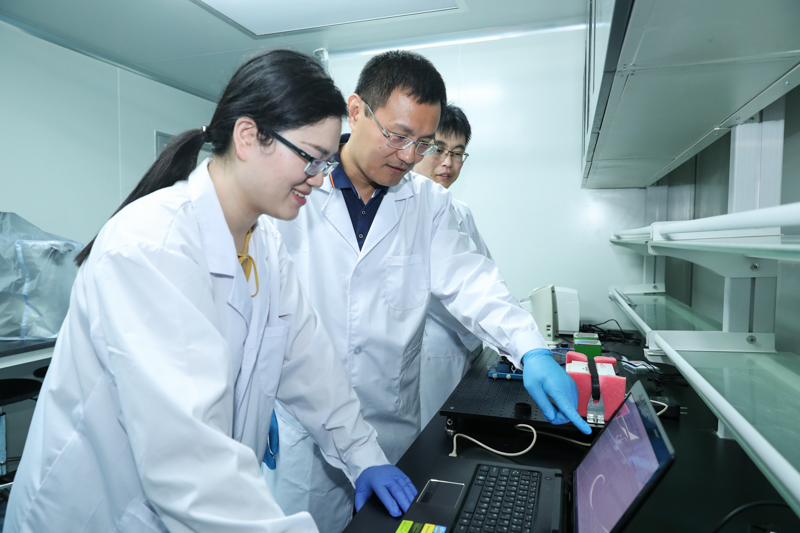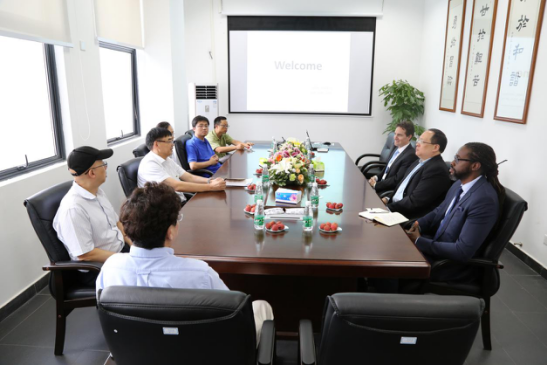
Author: admin
Professor Wu Changfeng Published Researh Results on Biomedical Sensors in ACS Nano
Recently, Biomedical Engineering Professor Wu Changfeng’s research group has made new progress on biomedical sensors by developing an ultrasensitive Pdot transducer for real-time, wireless in vivo glucose monitoring via a smartphone. The results were published in the American Chemical Society’s journal ACS Nano (Impact Factor 13.942). Sun Kai, a Ph.D. candidate from Jilin University was the first author.

Professor Wu Changfeng
As one of the world’s biggest health concerns, diabetes can cause numerous complications in heart, kidney, retina, and neural system. Since 11% of the Chinese population are diabetic, and 36% are prediabetic, Professor Wu took part in an interview to elaborate on the research’s significance for diabetes patients and the massive prediabetic population in the country.
“Continuous detection of blood glucose level is essential to manage diabetes progression and treatment, which involves a glucometer and finger-pricking for many diabetics. The measures can cause discomfort or pain, and they cannot monitor the continuous changes in blood glucose level.” said Professor Wu: “For severe diabetic patients, they need subcutaneous electrochemical sensors to keep track of real-time fluctuations in their blood glucose level. Though electrochemical sensors can provide valuable, comprehensive data, they have several drawbacks including in vivo sensor degradation within a week (which requires replacement and reimplantation), the poor response at low glucose concentrations, the pain of insertion, and risk of infection from the electrodes.”
Optical methods for glucose sensing have the potential to overcome the limitations of electrochemical sensors. However, these schemes have not had the clinical success of electrochemical methods for point-of-care testing because of the limited performance of optical sensors and the bulky instruments they require. Professor Wu’s research team saw the advances in nanotechnology that could offer solutions to overcome the problems with current optical glucose monitoring devices. As promising fluorescent materials, semiconductor polymer dots (Pdots) have attracted considerable attention for their applications in biological imaging and biosensors because of their high brightness, excellent stability, and biocompatibility.
Wu Changfeng et al. have recently developed an optically bright Pdot oxygen transducer that consists of an oxygen-consuming enzyme for sensitive detection of small-molecule substrates. The transducer−enzyme assembly after subcutaneous implantation provides a strong luminescence signal that is transdermally detectable and continuously responsive to blood glucose fluctuations. The team eventually designed an ultrasensitive Pdot transducer for wireless glucose monitoring via a smartphone. By using the longer lifetime palladium porphyrin complexes, the Pdot transducer exhibited a significantly higher sensitivity in both in vitro and in vivo glucose detection. With the ultrasensitive transducer, it was possible to differentiate clearly between euglycemia and hyperglycemia using luminescence images taken with a smartphone camera.
Wu et al. further developed an image-processing algorithm to decompose the fluorescence image via the RGB model. Based on the algorithm, a software application was developed and installed on a smartphone. They demonstrated a wireless, real-time, dynamic glucose monitoring of blood glucose level using the implanted transducer and the smartphone. The miniaturization of the optical monitoring platform can promote the innovative development of optical monitoring approaches in diabetic healthcare. Furthermore, by taking advantage of the mobile platform, the blood glucose data can be stored and uploaded to a database for personal healthcare, and this can aid the understanding and prediction of public health status through big data analysis.

Wu’s Research Group on Campus
“It’s taken us six years to achieve a breakthrough in the project, which means the article’s first author Sun Kai finished his one and only time-consuming project right before graduation.” said Professor Wu. “Despite its creativity and innovation, our project has only completed the first phase. We have only applied our in vivo glucose monitoring to lab rats, and we hope our project will enter the clinical trials soon by improving sensors and other materials. We still have a long way to go.”
When asked about the background of his research, Professor Wu Changfeng added: “Despite coming from different universities in China and United States, most teammates are my long-time friends and colleagues. I would like to specifically thank Sun Kai, who was my student when I was working at Jilin University. Moreover, one of the teammates Daniel Chiu (Professor of Washington University) helped me with the idea of in vivo smartphone glucose monitoring via an ultrasensitive Pdot transducer. Given the technological development at the time, the project was put on hold. But when I came back to China, the technological advancement and friendly environment for research prompted me to pick up the research again and achieve a breakthrough.”
Wu et al.’s project was also supported by the National Natural Science Foundation of China and Shenzhen Scientific and Technological Innovation Committee.
Links to the Wu et al.’s research papers:
Associate Dean of Engineering School from Columbia University Visits Our Department
On Monday 25 June, Associate Dean Barclay Morrison from Columbia University’s School of Engineering led a delegation including Associate Professor Lance C. Kam and Senior Lecturer Aaron Matthew Kyle from Columbia University’s Department of Biomedical Engineering.
The delegation met with Dean Xu Zhenghe from SUSTech’s College of Engineering, Founding Chair Guo Xiangdong, Chair Jiang Xingyu and Acting Chair Chen Fangyi from the Department of Biomedical Engineering, along with teachers from the Department of Biomedical Engineering for an informal discussion.

Dean Xu Zhenghe welcomed Barclay Morrison and his delegation. He introduced the wide range of cooperations and exchanges that SUSTech takes part in with other famous universities around the world, including MIT and UBC. Senior Lecturer Aaron Matthew Kyle introduced the capstone course of biomedical engineering at Columbia University, and both sides talked about jointly training students, cooperating on teaching research and other areas of cooperation between SUSTech and Columbia University.
Later, Associate Dean Barclay Morrison and his team were taken to the teaching laboratories at the Department of Biomedical Engineering and provided one-on-one guidance about the core courses in the Department.

Background:
In 2016, when the Department of Biomedical Engineering was established, both universities signed a Memorandum of Understanding between the Schools of Engineering, around academic cooperation and exchange. The two Departments of Biomedical Engineering would reach a consensus on a variety of issues, including student training, student communication, and curriculum guidance. The exchange would further promote the development of cooperation between the two Schools of Engineering and Departments of Biomedical Engineering.
Sensory Adaptation by Stochastic Adaptive Sampling in Receptor Neurones—— A Multi-scale Modelling Approach

Computational Systems Medicine: Looking Forward

Advanced In Vivo Fluorescence Imaging: Seeing is Believing

Columbia-SUSTech Biomedical Engineering Symposium

2018 SUSTech Global Scientist Forum
The Global Scientist Forum of Southern University of Science and Technology (SUSTech) is an important platform for talent recruitment.
The first Global Scientist Forum of SUSTech was successfully held in 2016, and 14 scholars were awarded the “Thousand Youth Talents” title by applied through SUSTech last year, which ranked No. 9 among all higher education institutes in China.
To encourage interdisciplinary academic innovation, and provide an exchange platform to young scholars for idea discussion and brainstorm, SUSTech is going to host the 2018 Global Scientist Forum during January 5-7, 2018 in Shenzhen, China. We welcome all young scholars at home and abroad to register and consult !
1.Introduction
The Global Scientist Forum at Southern University of Science and Technology (SUSTech) aims to provide a platform for brainstorm and academic exchanges among young scholars at home and abroad, to promote interdisciplinary and academic innovation, and discuss the approach for the construction of world-class universities and disciplines. Through the recruitment of world-class talents, we plan to build SUSTech into a high-level research university with unique characteristics in the world.
2.Qualifications for Applicants
(a) Under the age of 40
(b) Doctoral degree obtained from international renown universities and institutes; or Ph.D graduated from domestic universities while working abroad for more than 3 years, with certain achievements in related fields or good potential for further development; scholars with certain academic influence in the related field. Scholars from all areas are welcome.
3. Forum Schedule
Registration Date: January 5, 2018
Date of the Forum: January 6-7, 2018
4.Application
Please submit your CV to institutional mailbox of SUSTech Academy for Advanced Interdisciplinary Studies (aais@sustc.edu.cn) and intended department mailbox (see the list of departments/schools in the end), entitled “SUSTech Global Scientist Forum Application-intended department (eg. Mathematics…)” for evaluation. The application will close at December 15, 2017. Successful applicants will receive the invitation before December 20, 2017.
5.Travel and Accommodation
(a) Free accommodation and lodging will be provided.
(b) Travels: All invited scholars need to purchase their own tickets (economic class). We will provide travel reimbursement for the actual cost of tickets between 12/30/2017-01/13/2018 (maximum CNY 12,000 per person).
6.Contact Information
Dr Kun Yang, Tel: +86-75588015717, Email: yangk@sustc.edu.cn
Dr Huihui Sun, Tel: +86-755-88015716, Email: sunhh@sustc.edu.cn
Contacts of departments are listed in the end.
7.Salary and Benefits
SUSTech will provide generous remuneration to our school’s successful recipients of the “Thousand Youth Talents Program”as well as complete working and living conditions. In addition to national funds (CNY 1-3 million) and subsidies (CNY 500,000), Guangdong Province will support each Thousand Youth Talent start fund for scientific research of CNY 500,000 and settled fund of CNY 250,000. Meanwhile, Shenzhen will provide each Thousand Youth Talent start fund for scientific research of CNY 3-5 million (5 million for engineering, medicine, life science and experimental science; 3 million for theoretical science) and settled fund of CNY 2 million ( “Shenzhen peacock talent plan B” ); SUSTech will also support start fund for scientific research of CNY 1 million.
Contacts:
Yizhen Zhang
+86-755-88015137
bmehr@sustc.edu.cn

